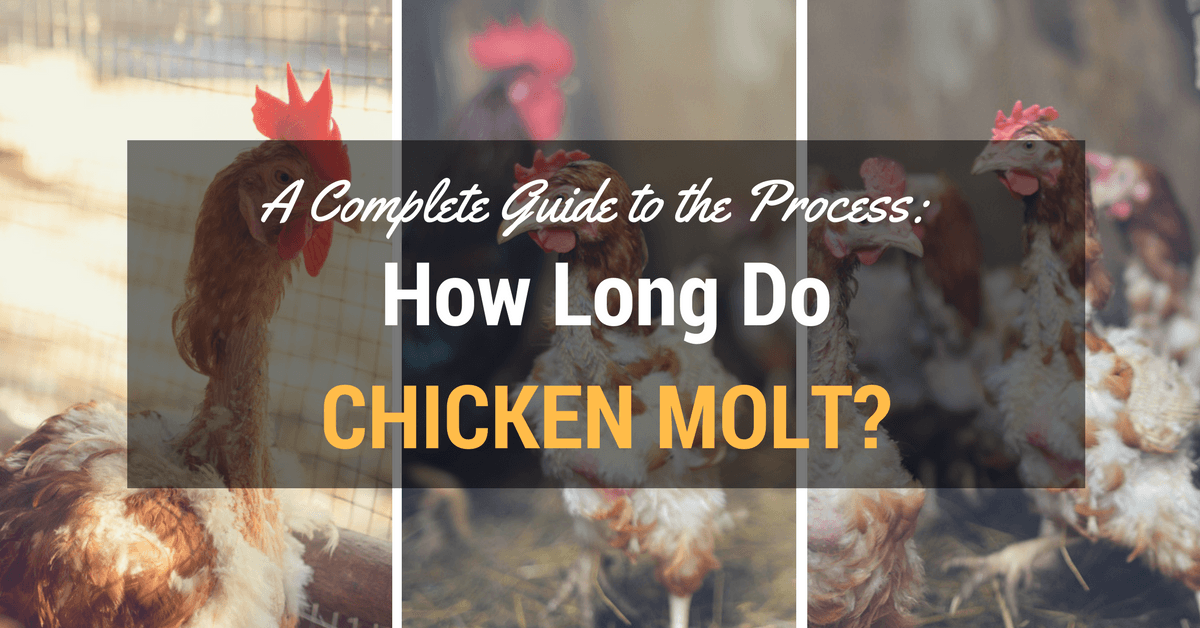A Complete Guide to the Process: How Long Do Chickens Molt?
A lot of people wonder when and how long do chickens molt? What happens during the process?
Chicken raisers tell us that the process supposedly happens either during the end of summer or spring.
In fact, experts suggest that during molting, the chickens start to shed off and replace their feathers in the course of a few weeks. So, in this article, let us find out more about the molting process.
More...
Overview of Molting

Molting is an essential and natural process wherein your chickens tend to break, lose, and wear out their feathers.
That way, they can renew them on a regular basis. It is significant that chickens develop their new feathers regularly. The integrity of a fowl’s feathers determines how it can keep itself warm during cold conditions.
Your chickens will undergo a few molts during their lifespan. On the first juvenile molt happens when your chick is about six to eight days old. Your peep starts to lose its covering to replace it with feathers.
Additionally, the second juvenile molt occurs when the fowl is around eight to twelve weeks old. They begin changing their baby feathers with the second layer during this time.
The second juvenile molt happens when male chicken feathers start to develop. Some backyard chicken raisers also discover the sexes of the chicken that they have to rehome.
How Long Do Chickens Molt?
When do birds start to molt? Chickens usually go through their adult molt when they are about 18 months old.
Adult molting in chickens happens during summer or fall wherein the feathers fully develop within eight to twelve weeks. But, not all chickens undergo molting in a traditional manner.
On an average, the process takes about 4 to 6 months from start to finish. However, it may also occur in a usual manner from 2 to 3 months and even more.
What Triggers Molting?

The standard trigger when your chicken molts are the drop off of daylight hours and the egg-laying cycle’s end. They usually happen during late summer or fall. But, there are a few less mild causes for this method.
You see, physical stress, malnutrition, inadequate water supply, hatching eggs, too much heat, and extreme lighting conditions can lead to unexpected molting.
Unfortunately, it is expected for commercial egg-laying farms to induce molting of its flocks for improved egg production. Also, it causes efficiency in producing eggs.
For keepers to force a molting process, the farm stops any feed from the chickens for seven to fourteen days.
During these days, they cause too much stress on the bodies of the chickens. Thus, this will lead to molting. Because of its cruelty to animals, it has removed in Europe and U.K.
How to Help Your Chickens Molt
The feathers of your fowls compose 80 to 85 percent of protein. A chicken’s body during this process cannot support egg and feather production at the same time.
In fact, initially, you will get confused why your chickens stop laying eggs so suddenly. Molting also causes a decrease in egg productivity until the chicken can replace its feathers completely.
Chicken keepers wonder what they have to feed their hens during the molting process to help them. The key here is to provide more protein in their diet. Layers supply about 16 percent of protein.
So, during molting, you have to change this to a broiler blend, which comprises 20 to 25 percent of protein.
Also, you can offer them protein-rich treats., including nuts, soybeans, peas, sunflower seeds, and meat. You can also give a cod liver oil, soft dog or cat food, and bone meal.
For some chicken raisers, you can also give them baked corn bread, which is rich in protein. You can use a typical corn bread recipe that you may find on a corn meal pack.
You also have to give them flaxseeds, nuts, yogurt in a batter, and dried fruits. These additional ingredients will increase the treat’s protein content.
So, it will help your chickens get their feathers back rapidly. As a bonus, the flock will also enjoy this snack when you serve it during the winter.
But, before you keep yourself calm during the process, you have a lot of things to consider. You have to bear in mind that there are numerous molting problems during this process.
One is that you have to remember that your bird gets uncomfortable when you handle their pin feathers. Also, when your chicken is undergoing a challenging molting process, they may expose their skin fully.
So, take note that they are more susceptible to bullying and pecking by other chickens. What you need to do is to watch out on this molting chicken carefully.
Conclusion
Molting is such a hard time for your chickens. In fact, it engages your chickens to hormonal changes and boosted energy needs. What you can do is to support your chicken for a few weeks until the process is complete.
Thus, you have to get rid of stress during this period. What you have to do is to provide warmth to your birds, give high protein diet, and be careful when handling your chicken. That way, your chickens will go through the process successfully.


